

|
||||
|
North of the town of Spencer, Massachusetts, at the crest of a steeply sloping hill blanketed in oak, maple and pine, but bared in part by farmed meadows and broad pasturelands, rests Saint Joseph's Abbey, a cloistered Roman Catholic monastery of monks of the Cistercian Order of the Strict Observance, popularly known as Trappists. Set apart from the actions and trends of most of their neighbors, they live a contemplative life, dedicating themselves to the praise and worship of God in a hidden life within their monastery. Following Saint Benedict's sixth century Rule for Monasteries, the monks live in silence and solitude, in prayer and penitence, thus rendering God "a service that is at once humble and noble." Since the brothers are of one heart and one mind, they have everything in common for the monastery is a school of love. 
|
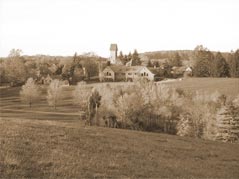
The Lord Jesus, revealed in scripture and holy tradition, is their strength. The monks are guided in the practice of the spiritual life through the direction and counsels of their abbot. The Order began in France in 1098 as a reform stressing simplicity of life and careful fidelity to the Rule. God's wonderful grace has sustained this endeavor through the centuries including our own history as a religious community beginning in 1825. The history of a monastic community, like the story of any family, is a narrative of perseverance and adaptation. The monastic reformers who founded the Cistercian Order in 1098 identified themselves as "lovers of the Rule and of the place." The monks of Saint Joseph's Abbey rejoice in their legacy and try to embody that same love. |
|||
|
Monks live apart from the world but are unable to avoid the world's turbulence in any time. Our own heritage is directly linked to the turmoil of the late eighteenth century. The age that witnessed profound revolutionary movements in Europe was not hospitable to religious Orders. During the French Revolution, Father Augustine de Lestrange led into exile a group of Cistercians from La Trappe, seat of the abbot De Rancé's famous reform. These refugees found a home in the abandoned Carthusian monastery of La Val Sainte in Switzerland and pursued their monastic lives with an austerity that surpassed even La Trappe's. De Lestrange, who was anxious to preserve the Trappist monastic witness in the face of European hostility, looked to America, and in 1803 he sent twenty monks from La Val Sainte to make a foundation. These pioneers struggled for eleven years in a number of different locations before returning to France in the wake of Napolean's defeat. By chance (or was it by design?) one monk, Father Vincent de Paul Merle (1768-1853), was left behind in Halifax, Nova Scotia in May 1815. 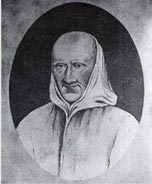
Father Vincent de Paul Merle |

Father Vincent de Paul, by all accounts, was blessed in equal measure with practicality and sanctity. While his determination to erect a permanent Trappist monastery never flagged, he offered his pastoral services to the Bishop of Québec and zealously served the Acadians and Micmac Indians in what is now the Diocese of Antigonish. By the late fall of 1819 he had found a tract of land at Tracadie, Nova Scotia that was suitable for his original purpose, and he made the necessary arrangements with de Lestrange then residing at the French monastery of Bellefontaine to begin the foundation of Petit Clairvaux. The first community numbered only five, and new vocations were scarce because of the fervor with which the monks aimed to observe the monastic life as it had been embodied in de Lestrange's rigorous interpretation of the Trappist reform. |
|||
|
The rigors of life at Petit Clairvaux were an obstacle to recruiting new members during the community's early years. Looking to France for reinforcements, both Father Vincent de Paul and his confrere, Father Francis Xavier Kaiser, (1785-1862) made the journey home in 1836 and 1845, respectively. Alas, neither was successful. Finally, however, in 1857, the Belgian monastery of Saint Sixtus responded to the appeal from Father Francis Xavier, who had assumed charge of Petit Clairvaux when Father Vincent died in 1853. Between 1857 and 1862 eighteen Flemish speaking monks left their home and adopted the rigors of a new land and language with the struggling community at Tracadie. The remarkable courage and faith with which these monks responded to the needs of Petit Clairvaux continue to move us and, more importantly, to challenge us. 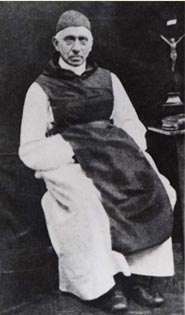
Dom James Deportemont, (1803-1883) Petit Clairvaux became an autonomous abbey in 1876, and the monks elected one of the Belgians, Dom Dominic Schietecatte (1834-1919), as the first abbot. In 1882, the French monastery of Bellefontaine, which considered the founders of Tracadie to have been monks of their community, assumed the role of motherhouse. The community had taken root in Nova Scotia - by 1886 there were forty-five monks - and the struggle of three-quarters of a century appeared to have brought Father Vincent de Paul's dream to fruition. Then disaster struck. On October 4, 1892 the abbey church and the entire monastic quadrangle burned to the ground. Though none of the monks was injured, all of the community's possessions, including liturgical vestments, books and the archives were lost. The monks, with characteristic resolve, began to rebuild in 1894. However, an additional, major set back occurred in the fall of 1896 when the monks' temporary quarters and barns were destroyed in another fire. Not surprisingly, these events exacted a heavy emotional toll. Dom Dominic, discouraged and ailing, resigned his office and returned to Belgium with several of the Flemish monks. Dom Antoine Oger, the abbot of Notre Dame du Lac, at Oka, Québec, was given charge of Petit Clairvaux and appointed Oka' prior, Dom John Mary Murphy (1849-1913), as acting superior. Some members of the community were dispensed from their vows; others remained to work in the local diocese. By 1898 only twelve monks remained at Petit Clairvaux. At the time it would have seemed that Father Vincent de Paul's ambitious venture had, simply, failed. |
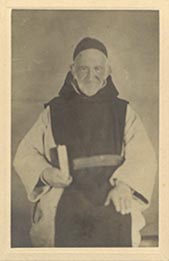
Father Francis Xavier Kaiser, (1785-1862) The arrival of Father James Deportemont with the Belgian monks infused new life into Petit Clairvaux. Like their medieval predecessors, the community engaged in agriculture with imagination and industry and became, in time, a model for the whole area. The stability of the community was reinforced in 1869 when the monastery was officially affiliated with the Cistercian Congregation of La Trappe. At the same time, the Abbey of Gethsemani, which was founded in Kentucky in 1848, was designated as Petit Clairvaux's "motherhouse" in which capacity it could be relied upon for fraternal oversight and support. As numbers increased at Petit Clairvaux, Dom James Deportemont started another foundation in the Province of Québec in search of a more promising region for local vocations. Our Lady of the Holy Spirit in Langevein County survived only from 1862 to 1872 but nonetheless gave evidence of the attraction that monastic life continued to exert. Indeed, the Québec community itself established a foundation in Old Monroe, Missouri that lasted from 1867 to 1875. 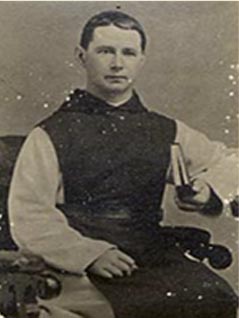
Dom John Mary Murphy, (1849-1913) |
|||
|
The community's "modern" history has been no less eventful; indeed, our very survival provides a living commentary on St. Paul's question, "If God is for us, who can be against us?" By the end of the last century, with the community's buildings and morale in disrepair, it was clear that Petit Clairvaux needed to move if it was to have any hope of achieving permanence. But Divine Providence was watching and once again the Order came to the rescue. Notre-Dame du Lac had been founded near Montreal by Bellefontaine in 1881 and it is due to this community's great charity that Spencer exists today. Consequently in 1899, Father John Mary Murphy petitioned the General Chapter of the Order to move the monastery from eastern Nova Scotia to the Diocese of Providence, Rhode Island. 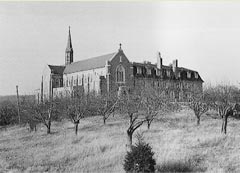
Under Dom John's leadership, the community's prospects solidified. He oversaw the construction of the monastic church (finished in 1928); the Chapter and Novitiate wings (1931 and 1937 respectively); and the large Porter's Lodge (1938). The monks constructed all of the buildings with pigeon gray granite they quarried on their own property. At the time the granite might have seemed an apt and comforting metaphor for the community's future, and by the time Dom John resigned his office, in 1943, they numbered eighty-four, Dom John laying down the burden of office after thirty years of wise and humble service, leaving behind the memory of a truly meek, silent and self-effacing superior. In the middle of World War II, Dom Edmund Futterer (1901-1984) was appointed superior of Our Lady of the Valley and was elected abbot in 1945. Dom Edmund seemed to have inherited Father Vincent de Paul's energy and vision, and the early years of his abbacy were filled with expansion. On March 21, 1950, the Feast of Saint Benedict, the monks were reminded once again that the ways of God are not our ways. The abbey was ravaged by fire, and the devastation was virtually complete. The original wing was destroyed; the church was rendered structurally unsound and had to be demolished; and the Chapter wing needed extensive repairs. Once again, the community, numbering 140 persons, was homeless. After the war, there was a stunning resurgence of interest in the contemplative life, and numbers at the Valley and at other monasteries of the order throughout the United States, rose spectacularly - in 1948 there were one hundred thirty-seven monks in the Rhode Island monastery. Thirty-four monks and novices set out that year to establish Our Lady of Guadalupe near Santa Fe, New Mexico. This community, which celebrated its own anniversary in 1998, now lives in Lafayette, Oregon. |
The small community, accompanied by their livestock, arrived in New England in the summer of 1900, and regular monastic life was resumed on August 2. Their new home was a tract of some three hundred stony acres in Lonsdale, Cumberland Township, and the monastery was called Our Lady of the Valley since it was situated in Rhode Island's Blackstone Valley. The monks were diligent and resourceful as they began once again to build a monastery. By 1902, they had erected an imposing front wing in which they lived and prayed for the next twenty-five years. Progress was slow but deliberate. To the hardships of an entirely new beginning was added the rather puzzling news of 1906 that the community's transfer, though formally approved by the General Chapter, had entailed the forfeiture of the abbatial status. The monks on occasion had to cope with the exigencies of poverty and illness but despite this within about ten years the community had doubled in size. Dom John Mary died in 1913 and was succeeded by Dom John O'Connor (1864-1945), a monk of Petit Clairvaux who arrived via Oka where he had just been ordained. 
Dom John O'Connor, (1864-1945) Meanwhile, Dom Edmund turned his attention to the introduction of the Cistercian ("Trappistine") nuns into the United States. With the most generous collaboration of the then Archbishop, later Cardinal, Cushing of Boston, Mount Saint Mary's Abbey in Wrentham, Massachusetts was opened on September 30, 1949. This flourishing monastery is already the proud motherhouse of three other communities in Iowa (1964), Arizona (1972), and Virginia (1987), as well as a contributor to a new monastic presence at the site of the medieval Cistercian monastery of Tautra in Norway. |
|||
|
The postwar economic development of New England had significant consequences for the community. As the population in the area around the monastery increased, the monks needed to find a new location that would insure both their solitude and their economic stability. With this end in mind, in 1949 the community had purchased a large agricultural property, Alta Crest Farms in Spencer, Massachusetts. The 1950 fire merely accelerated the community's projected move. And the end of one story became the seed for a number of new ones. The monks set to work adapting the farm buildings for monastic purposes while using an abandoned Civilian Conservation Corps Camp in northern Rhode Island as temporary living quarters. Despite the austere living conditions, the community's ranks continued to swell, and a new foundation was undertaken. Thus, on November 18, 1950, thirty-four professed monks and novices set out for Berryville, Virginia to establish Our Lady of the Holy Cross. 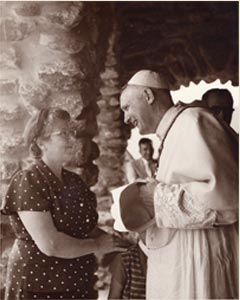
Dom Edmund Futterer, (1901-1984) |
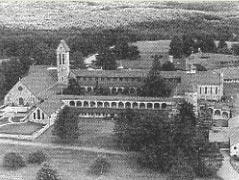
On December 23, 1950, eighty monks took possession of Saint Joseph's Abbey, Spencer. During the Abbey's early years, the growth of the community continued to be phenomenal. Ground for Spencer's abbey church and quadrangle was broken on March 19, 1952 and hardly a year later, on August 15, 1953, the first Mass was solemnly celebrated in the new church. There were one hundred fifty-six monks in the community; the number grew to one hundred eighty-six by 1957. A third foundation was imperative, and property was secured on the western slopes of the Great Divide, in Snowmass, Colorado. The brothers who had been apprenticed in the building trades during the construction of Spencer were sent to the new site and had completed two wings of the monastery, dedicated to Saint Benedict, by November 21, 1958 when thirty-five monks from Spencer arrived. In that same year the numbers were propitious for yet another foundation, and Dom Edmund seized the opportunity to introduce Cistercian life to South America. A group of monks, many of whom had contributed to the distinctive design and construction of both Spencer and Snowmass, set out for Argentina and established Nuestra Señora de los Angeles at Azul in the Province of Buenos Aires. This Spanish-speaking Abbey has grown steadily and continues to flourish. Spencer started another South American community, Nuestra Señora de La Dehesa, in 1960 near Santiago, Chile. |
|||
|
However, by the middle years of that decade, it became difficult for Spencer to continue to furnish personnel for La Dehesa. Subsequently, our sister-abbey in Kentucky, Gethsemani, assumed responsibility for this daughter house, which prospered and became a semi-autonomous Priory in 1970. On August 1, 1961 Dom Edmund Futterer resigned after serving his community and his daughter-houses of monks and nuns with extraordinary vision and enlightened zeal for eighteen years, in an era of expansion and change. He will surely be recognized to have been one of the outstanding abbots of the 20th century for his material contribution but even more so as an eminent master of the interior life and a loving spiritual father. Dom Edmund was succeeded by the superior of the Snowmass community, Dom Thomas Keating (1923- ). Dom Thomas' abbacy coincided with the Second Vatican Council and its tumultuous aftermath. He resigned on September 10, 1981 after two decades in office spanning the troubled Sixties and the reappraisals of the Seventies. 
|

Dom Thomas was succeeded by Dom Paschal Skutecky (1920-2000), whose term was brief due to poor health. Dom Augustine Roberts (1938- ), Titular Prior of Spencer's daughterhouse in Argentina, became Administrator in June 1983, and then Abbot one year later in June 1984. After two six-year terms, during which Dom Augustine oversaw the construction of a new Infirmary, he was succeeded as Abbot by Dom Damian Carr (1948- ) on June 17, 1996. In August 1969, we were reunited with a number of our departed brothers when the remains of all those who had been buried at Our Lady of the Valley - including monks from Petit Clairvaux, Saint Sixtus and Notre-Dame du Lac - "Separated neither in life nor in death," were re-interred in our monastic cemetery at Spencer. They now await the resurrection among their younger brethren. Their presence among us is a forceful witness of sacrifice and determination. In their lives - in our past - where we see God's plan unfolding ceaselessly, we can also discern the architecture of our future and each day celebrate it with the Psalmist's voice... |
|||
 |
||||
|
Home | Back to Top | Contact Us | Links |